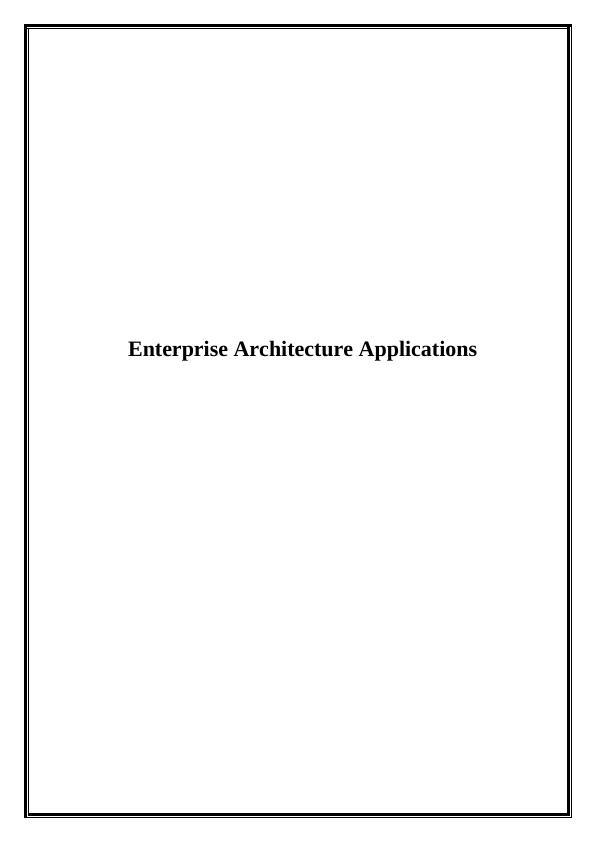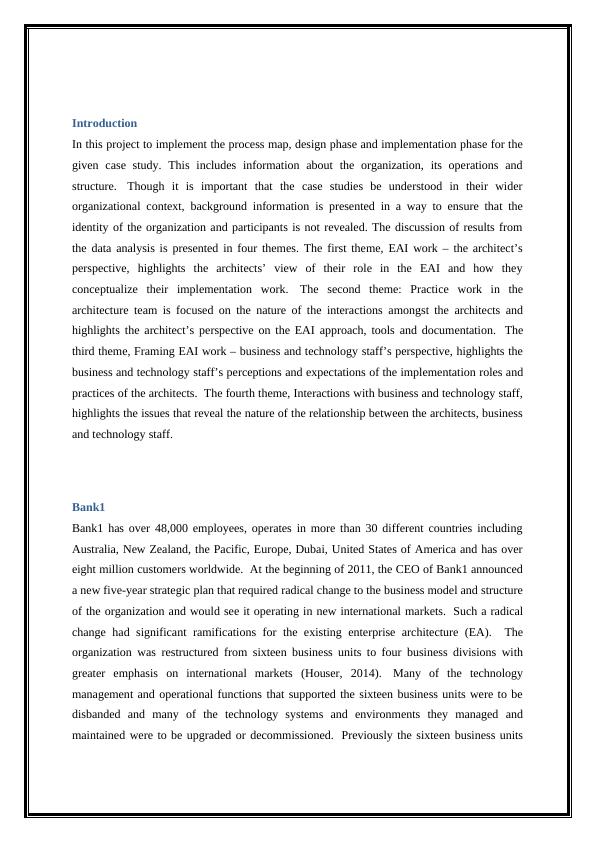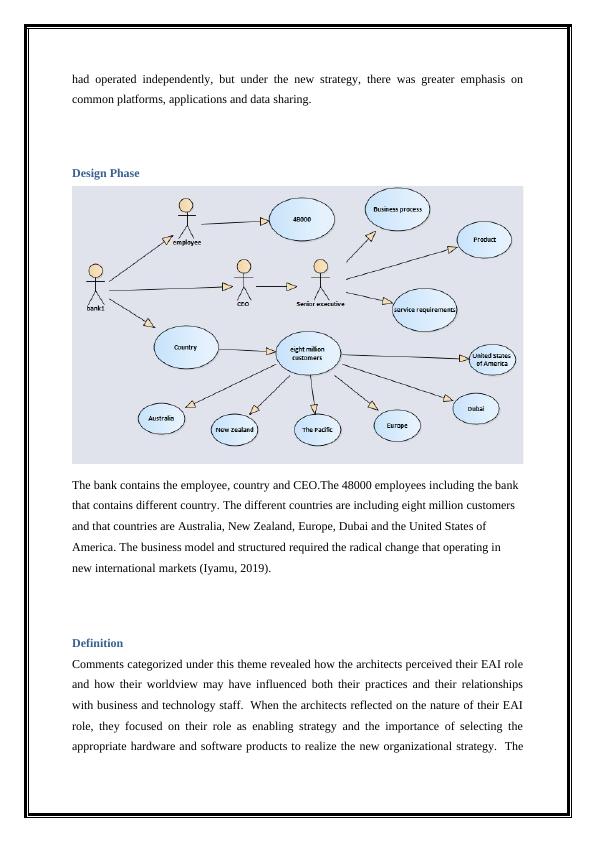Enterprise Architecture Applications Contents
Added on 2022-10-12
12 Pages2343 Words195 Views
Enterprise Architecture Applications


Introduction
In this project to implement the process map, design phase and implementation phase for the
given case study. This includes information about the organization, its operations and
structure. Though it is important that the case studies be understood in their wider
organizational context, background information is presented in a way to ensure that the
identity of the organization and participants is not revealed. The discussion of results from
the data analysis is presented in four themes. The first theme, EAI work – the architect’s
perspective, highlights the architects’ view of their role in the EAI and how they
conceptualize their implementation work. The second theme: Practice work in the
architecture team is focused on the nature of the interactions amongst the architects and
highlights the architect’s perspective on the EAI approach, tools and documentation. The
third theme, Framing EAI work – business and technology staff’s perspective, highlights the
business and technology staff’s perceptions and expectations of the implementation roles and
practices of the architects. The fourth theme, Interactions with business and technology staff,
highlights the issues that reveal the nature of the relationship between the architects, business
and technology staff.
Bank1
Bank1 has over 48,000 employees, operates in more than 30 different countries including
Australia, New Zealand, the Pacific, Europe, Dubai, United States of America and has over
eight million customers worldwide. At the beginning of 2011, the CEO of Bank1 announced
a new five-year strategic plan that required radical change to the business model and structure
of the organization and would see it operating in new international markets. Such a radical
change had significant ramifications for the existing enterprise architecture (EA). The
organization was restructured from sixteen business units to four business divisions with
greater emphasis on international markets (Houser, 2014). Many of the technology
management and operational functions that supported the sixteen business units were to be
disbanded and many of the technology systems and environments they managed and
maintained were to be upgraded or decommissioned. Previously the sixteen business units
In this project to implement the process map, design phase and implementation phase for the
given case study. This includes information about the organization, its operations and
structure. Though it is important that the case studies be understood in their wider
organizational context, background information is presented in a way to ensure that the
identity of the organization and participants is not revealed. The discussion of results from
the data analysis is presented in four themes. The first theme, EAI work – the architect’s
perspective, highlights the architects’ view of their role in the EAI and how they
conceptualize their implementation work. The second theme: Practice work in the
architecture team is focused on the nature of the interactions amongst the architects and
highlights the architect’s perspective on the EAI approach, tools and documentation. The
third theme, Framing EAI work – business and technology staff’s perspective, highlights the
business and technology staff’s perceptions and expectations of the implementation roles and
practices of the architects. The fourth theme, Interactions with business and technology staff,
highlights the issues that reveal the nature of the relationship between the architects, business
and technology staff.
Bank1
Bank1 has over 48,000 employees, operates in more than 30 different countries including
Australia, New Zealand, the Pacific, Europe, Dubai, United States of America and has over
eight million customers worldwide. At the beginning of 2011, the CEO of Bank1 announced
a new five-year strategic plan that required radical change to the business model and structure
of the organization and would see it operating in new international markets. Such a radical
change had significant ramifications for the existing enterprise architecture (EA). The
organization was restructured from sixteen business units to four business divisions with
greater emphasis on international markets (Houser, 2014). Many of the technology
management and operational functions that supported the sixteen business units were to be
disbanded and many of the technology systems and environments they managed and
maintained were to be upgraded or decommissioned. Previously the sixteen business units

had operated independently, but under the new strategy, there was greater emphasis on
common platforms, applications and data sharing.
Design Phase
The bank contains the employee, country and CEO.The 48000 employees including the bank
that contains different country. The different countries are including eight million customers
and that countries are Australia, New Zealand, Europe, Dubai and the United States of
America. The business model and structured required the radical change that operating in
new international markets (Iyamu, 2019).
Definition
Comments categorized under this theme revealed how the architects perceived their EAI role
and how their worldview may have influenced both their practices and their relationships
with business and technology staff. When the architects reflected on the nature of their EAI
role, they focused on their role as enabling strategy and the importance of selecting the
appropriate hardware and software products to realize the new organizational strategy. The
common platforms, applications and data sharing.
Design Phase
The bank contains the employee, country and CEO.The 48000 employees including the bank
that contains different country. The different countries are including eight million customers
and that countries are Australia, New Zealand, Europe, Dubai and the United States of
America. The business model and structured required the radical change that operating in
new international markets (Iyamu, 2019).
Definition
Comments categorized under this theme revealed how the architects perceived their EAI role
and how their worldview may have influenced both their practices and their relationships
with business and technology staff. When the architects reflected on the nature of their EAI
role, they focused on their role as enabling strategy and the importance of selecting the
appropriate hardware and software products to realize the new organizational strategy. The

End of preview
Want to access all the pages? Upload your documents or become a member.
Related Documents
A Post-Project Review of a Business Analystlg...
|31
|12469
|345
INF 80014 : Contemporary Issues in Business Analysislg...
|31
|12665
|110
